The “zebra” pedestrian crossing with its rectangular stripes is all too familiar. According to Wikipedia, it was introduced after WW2; but its roots appear much earlier in history…
During our recent tour of Pompeii I saw how the Romans approached the matter, which they did with their usual pragmatic attitude. Pompeii’s streets are paved with large black flagstones, and are flanked by tall sidewalks. And at frequent intervals these are connected by pedestrian crossings like these:

The similarity to our present day zebra crossing is striking, except that these stripes are as tall as the sidewalk and act as stepping stones. The reason is obvious: when the city was alive – before Vesuvius wiped it out with a belch – the streets must’ve been at various times packed with water, mud, trash and worse. The refined ladies who lived in the exquisite villas we see in ruin today were no doubt eager to keep their dainty sandals and flowing robes above street level as they went about their shopping.
And they had these crossings all over the town – from single-stone versions in smaller alleys to multiple crossings at large intersections, as you see below.

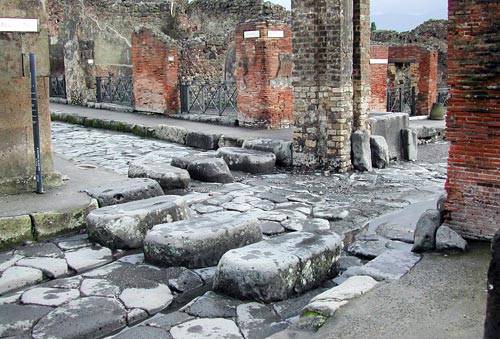
The nearer crossing in the last photo attests to another attribute of this design: note the deep narrow grooves along the road which go through the spaces between the stepping stones. The stones were spaced to the same width as the wheels on a standard cart, allowing wheeled traffic to drive through undisturbed, resulting in the eroded ruts you see in the photo.
The ancient Romans were amazingly like us…
If you want to learn how they lived, you have two options: watch the HBO series (which made an honest effort at historical accuracy), or go visit Pompeii, a lively town frozen in time by that devastating Vesuvian eruption in 79 AD.
I did both, and in Pompeii I snapped this mosaic floor at the street entrance of one of the houses:
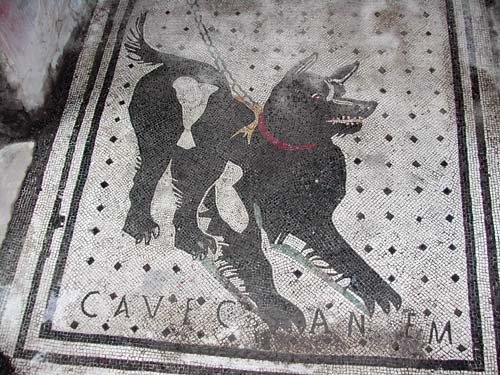
 Nice dog, this one: not too ferocious to allow sympathy, yet substantial enough to scare away thieves. And in case your Latin is rusty, CAVE CANEM means exactly what its modern counterpart in the image at right does (but then, Latin being an important influence in English, you could have identified the words in “Caveat” and “Canine”…)
Nice dog, this one: not too ferocious to allow sympathy, yet substantial enough to scare away thieves. And in case your Latin is rusty, CAVE CANEM means exactly what its modern counterpart in the image at right does (but then, Latin being an important influence in English, you could have identified the words in “Caveat” and “Canine”…)
I was watching 2001: A Space Odyssey again. Such a contrast to today’s special-effect-based space operas… an incredible movie by two giants, and not a bit of CGI in it, either (Sigh…)
Anyway, in the beginning Dr. Heywood arrives at the space station, and is subjected to a “Voice Print Identification” process as he enters a secure area. And it was in this very week that my bank had me record my voice for voice print ID, a new regulatory requirement for phone based transactions in this country.
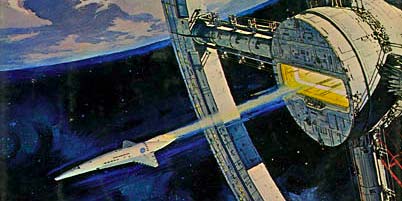
So, it is 2010, and the futuristic technology that Clarke and Kubrick envisioned in 1968 for use in 2001 is here. Unfortunately, that’s the least interesting prediction of this imaginative movie: we don’t have ubiquitous video telephony (Skype excluded), we don’t have a moon base, we don’t travel to Jupiter, and we don’t have an elegant space station that provides artificial gravity by rotating on its axis.
We do have a space station, true, but it looks like a pile of accreted floating junk… 🙁
There is a progression in the components of electronic computers. In the forties and fifties they were made of vacuum tubes; in the sixties, of transistors; in the seventies and later of increasingly dense silicon chips. And in the future, according to the vision of SciFi master Isaac Asimov, there will be positronic brains, small enough to fit in a robot’s skull, and they will be based on the interplay of positronic potentials in a platinum-iridium matrix. But wait… according to Hollywood, there will be something else.
Enter the 2004 movie “I, Robot”. This has its drawbacks, from the blatant product placement to the inevitable hyperactive hollywoodization of Asimov’s lovely book. Still, the CG robots are neat, and I enjoyed watching it – and something caught my eye about 66 minutes into the film. At that point, the robotic protagonist Sonny sketches its dream for the benefit of Will Smith, and it shuffles some loose notepaper on the lab workbench. The paper has the US Robotics letterhead, and is filled with scientific-looking schematics and stuff. But as one sheet of paper was uncovered for a second, I instinctively recognized a familiar symbol.
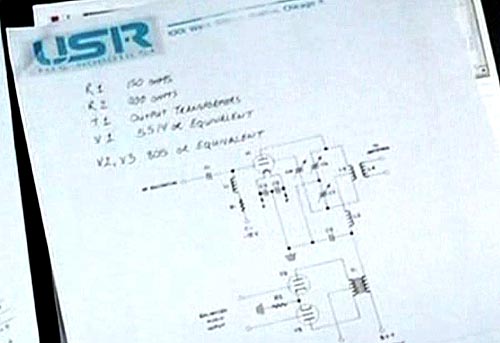
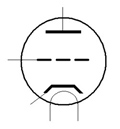 Here is the capture of that frame, and what I glimpsed are the three circles. They’re fuzzy enough, but to a techie of my generation they’re unmistakable: these are the symbols of triode vacuum tubes. In fact, the parts list above the schematic names some of them as “805 or equivalent”; the 805 was a hefty power amplifier triode, as specified here.
Here is the capture of that frame, and what I glimpsed are the three circles. They’re fuzzy enough, but to a techie of my generation they’re unmistakable: these are the symbols of triode vacuum tubes. In fact, the parts list above the schematic names some of them as “805 or equivalent”; the 805 was a hefty power amplifier triode, as specified here.
So – in 2035 they will have positronic brains of incredible miniaturization, and they will also make use of the clunky glass tubes that were in use during World War II. Right.
Whoever prepared the props for this scene must’ve grabbed the schematics and text from some old technical manual… and it can’t even be a matter of product placement, since these tubes are no longer in serious use. Just sloppiness…
Edible fruit have been on this planet since the Cretaceous, but they know how to move ahead with the times.
See the photo: this pear, recently arrived from our greengrocer, has a barcode on it!

Why does a pear need its own barcode? I could understand putting one on the crate, for easier shipping control and stock management; but nobody scans an individual pear, do they? In fact, people have been eating pears for ages (seven millennia, more or less), and for 99.9% of that time they managed just fine without a barcode, as you can see in this snippet from a botanical illustration from 1771.


And our modern pear has more than a barcode: it has a logo, and it has a catalog number, and – wonder of wonders – it has a Web site! This is nicely done, chock full of pear lore and fun. I’d joke that at this rate it will soon have its own fruity Facebook account, but of course, it already does. And it’s on Twitter, too: @usapears.
These Generation Y pears sure are getting ahead in our hyper-connected world! 🙂
 Check the new article on my History of Computing exhibit: a century old teaching aid from Germany, with the added twist that it anticipates today’s well known slogan: “To each pupil his own counting machine!”
Check the new article on my History of Computing exhibit: a century old teaching aid from Germany, with the added twist that it anticipates today’s well known slogan: “To each pupil his own counting machine!”
I was shopping at Office Depot, and next to the checkout line they had this bin full of cheap items on sale. And in it, thrown carelessly with less decorum than potatoes get at the grocer’s, were blister-packaged Flash memory cards.

They had 2.0 GB units selling for a pittance. That’s two billion bytes, or 16 Billion bits. I remember Thirty years ago, when a solid state memory board of 16K Bytes would come very carefully packaged – rightly so, as it cost thousands of dollars. The unit in the blister pack shown has a Million times as much capacity and costs 10 bucks. Of course we all know how Moore’s law is driving densities up and price per bit down, but this infamy of selling Gigabytes like peanuts brings it home with some poignancy.
And Below is a similar case, this from our neighborhood general store. Here the Flash Disk-on-key packs are hanging from a shelf alongside Energizer batteries, chocolates, candy and chewing gum packages.
You can bet the core memory stack I show here was not sold with chewing gum…

I was visiting a print design firm and noticed a pile of freshly printed business cards that had the shape of a rectangle with one corner cut off diagonally. I was delighted: this must clearly be the card of some IT professional who wanted to play on the shape of the IBM punched card, right?

Wrong, of course. I asked the designer and he said this is just a nice shape for someone wishing to stand out from the usual rectangular cards, but he didn’t even recognize that this is the form factor of a punched card. In fact, he’d never even seen such a card, even though they were all too common in his parents’ youth – not only in mainframe computer installations but also in every home, since they were used for utility bills to facilitate later data processing (see here). No one who was even slightly literate in the sciences could have missed the similarity back then.
Yet another iconic shape going away into the mists of oblivion…
A while back I was visiting the wonderful Museum of Business History and Technology in Wilmington, Delaware, which has countless typewriters, that incredible device that will soon be completely forgotten. Among these faithful servants of the authors of yesteryear I saw the device in this photo.
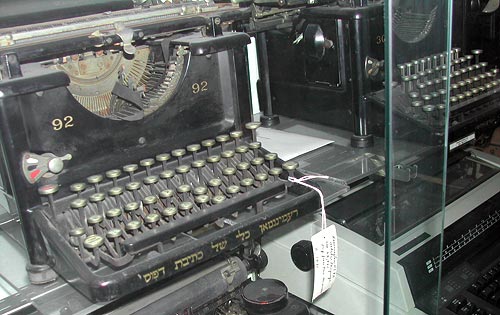
It’s an old Hebrew Remington 92 from around 1930, but what caught my eye was the Hebrew inscription on the frame, which translates literally into “Remington tool of writing type“. Now, the modern Hebrew name for typewriter means literally “writing machine”. And in fact, a little Googling will find you the same old model with this very phrase on it.
So what we’re seeing here is language in the making: the unit in the photo is so early that the term for it hasn’t jelled yet, and different batches were marketed with different names!
Speaking of which, I notice that the name for this machine, in every language I can make out, includes the root “write”, most commonly simply as “writing machine” (machine à écrire, macchina da scrivere, Schreibmaschine, máquina de escribir, etc). Nobody calls it a “printing machine”, even though that’s the immediate action. The important thing is that it is used for writing, in the good old sense that one did with a quill, or a pen, or a pencil, or a piece of chalk. It’s simply an accessory to the creative mind, and all these names – including the discarded one on the Remington 92 above – reflect that fact. Somehow, our computers and keyboards and printers and word processors have lost that linguistic flavor…
In the US, where I just gave a lecture at a conference on Information Load and Overload, and of course I found the time to visit the wonderful Computer History Museum in Mountain View. This is always a delight, but this time they surpassed themselves: they demonstrated the newly built Difference Engine #2 in action!
Charles Babbage’s incredible but never-built 19th century calculating machine was first realized in the nineties by the Science Museum in London, and now Microsoft millionaire Nathan Myhrvold commissioned this second replica. This one is complete with the printing mechanism; you crank the handle at one end, sequential values of 7th order polynomial functions are computed by the whirring mechanism, and ready-to-use plaster casts for printing the numbers in table form come out the other end, complete with multi-column formatting. The dance of the mechanism is really a thing of beauty; a visit to the museum is very recommended.
I saw it, and I have the photo to prove it!
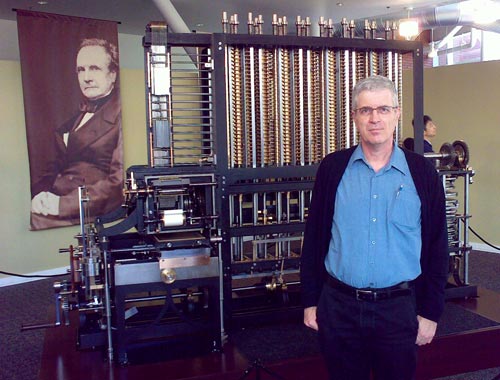




 Nice dog, this one: not too ferocious to allow sympathy, yet substantial enough to scare away thieves. And in case your Latin is rusty, CAVE CANEM means exactly what its modern counterpart in the image at right does (but then, Latin being an important influence in English, you could have identified the words in “Caveat” and “Canine”…)
Nice dog, this one: not too ferocious to allow sympathy, yet substantial enough to scare away thieves. And in case your Latin is rusty, CAVE CANEM means exactly what its modern counterpart in the image at right does (but then, Latin being an important influence in English, you could have identified the words in “Caveat” and “Canine”…)





 Check the
Check the 





